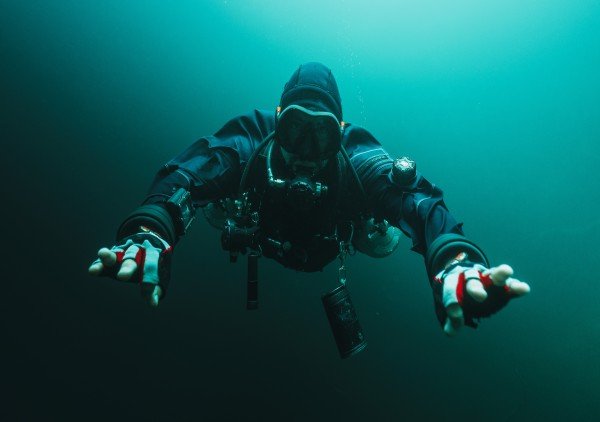By Third Interval Staff
There’s a moment after a dive—mask still damp, fingers puckered, sun burning down on salt-dappled shoulders—when a certain kind of diver experiences what can only be called a quiet compulsion. Not to log the dive (though they will), not to discuss the sighting of the zebra-striped nudibranch (though they must), but to clean.
Not just rinse, mind you. Clean.
To the uninitiated, the task is mundane: dunk your gear in freshwater and hang it up. But to the seasoned diver, or at least the obsessive one, this process becomes a ritual bordering on spiritual. There is a right way and, of course, a deeply wrong way.
“There is a right way and, of course, a deeply wrong way.”
Salt is the Enemy
Salt is, as every diver learns early, the destroyer of dreams. Left unchecked, it crystallizes into tiny razors that eat away at neoprene, corrode metal, and stiffen silicone until your once-flexible gear becomes brittle and useless. It does this quietly, invisibly, and with the vengeance of time.
So we rinse. Religiously.
The proper rinse begins with a soak, not a splash. Regulators, masks, snorkels, and computers—anything that has been submerged in seawater—deserve full immersion in fresh, lukewarm water. Not hot. Heat warps plastic and weakens seals. Five minutes, ten at most. Let it breathe.
BCD inflation valves should be flushed from the inside. Add water to the oral inflator, give it a shake like a bartender with a grudge, then purge it fully. Do this twice. If mold ever takes up residence in your BCD, no amount of denial will save you. It will smell like the ghost of a wetsuit left in the trunk of a car in midsummer.

The Mask and the Myth
There is, in some circles, a belief that masks do not need more than a cursory rinse. These people also believe that regulators “don’t really need servicing every year,” and should not be trusted.
Your mask should be rinsed, lens and skirt, then left to dry face-down on a soft towel—not a cement dock where scratches wait in ambush. Silicone skirts benefit from the occasional wipe-down with mild soap. Baby shampoo is the unofficial cleaner of the dive world—not because it’s particularly effective, but because divers, in general, are reluctant to buy anything they don’t need immediately.
Regulators: The Sacred Lung
Ah, the regulator. The one piece of gear that, when it fails, turns a casual drift dive into a life event.
“Do not press the purge button”
Rinse it attached to the tank, if you can. Keep the dust cap dry or sealed. If the cap is wet, drying it with your towel isn’t enough—moisture here can infiltrate the first stage and begin a slow death march of corrosion. Do not press the purge button while rinsing unless the regulator is pressurized. Doing so will invite water deep into the second stage, where it does not belong.
Once rinsed, hang it—not by the hoses, not in direct sun, and not in a tangle that would make a dive instructor sigh audibly.
The Wetsuit, a Living Thing
Wetsuits, too, are alive in a sense—porous, odor-retaining, and fiercely loyal to the scent of your last dive. A freshwater rinse is essential, but a soak with wetsuit shampoo every few dives will prolong its elasticity and prevent the dreaded aroma of forgotten dampness.
Hang it on a thick wetsuit hanger—shoulders supported, zipper unzipped. If you drape it over a wire hanger, you are not maintaining your gear. You are slowly executing it.
Storage: The Final Test of Character
Proper maintenance doesn’t end with the rinse. It ends with dry, dark, and cool. That is, your gear must be dry before it’s stored, kept out of direct sunlight, and never thrown into the trunk of your car “just until tomorrow.” Tomorrow becomes next weekend. Next weekend becomes mold.
Regulators belong in padded bags. Wetsuits should not be folded. Masks in boxes. Dive computers? Take the battery out if you won’t use it for a while, unless you like the smell of exploded lithium.
Masks in boxes.
The Gear as Memory
To clean your gear is not simply to maintain it. It is to revisit the dive. The fish you chased. The current that surprised you. The surface interval spent arguing over whether it was a frogfish or a poorly-behaved sponge.
In the gentle rinse of neoprene, in the hiss of purged BCDs, there is reflection. A quiet, meditative coda to the underwater symphony. The dive is over, but the ritual remains.
And for those of us who live between dives, who obsess over gear not just as tools but as extensions of our underwater selves, this ritual matters. Because salt is the enemy. But neglect? That’s worse.

